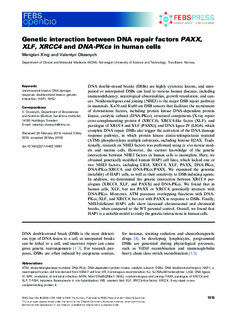| dc.description.abstract | DNA double‐strand breaks (DSBs) are highly cytotoxic lesions, and unrepaired or misrepaired DSBs can lead to various human diseases, including immunodeficiency, neurological abnormalities, growth retardation, and cancer. Nonhomologous end joining (NHEJ) is the major DSB repair pathway in mammals. Ku70 and Ku80 are DSB sensors that facilitate the recruitment of downstream factors, including protein kinase DNA‐dependent protein kinase, catalytic subunit (DNA‐PKcs), structural components [X‐ray repair cross‐complementing protein 4 (XRCC4), XRCC4‐like factor (XLF), and paralogue of XRCC4 and XLF (PAXX)], and DNA ligase IV (LIG4), which complete DNA repair. DSBs also trigger the activation of the DNA damage response pathway, in which protein kinase ataxia‐telangiectasia mutated (ATM) phosphorylates multiple substrates, including histone H2AX. Traditionally, research on NHEJ factors was performed using in vivo mouse models and murine cells. However, the current knowledge of the genetic interactions between NHEJ factors in human cells is incomplete. Here, we obtained genetically modified human HAP1 cell lines, which lacked one or two NHEJ factors, including LIG4, XRCC4, XLF, PAXX, DNA‐PKcs, DNA‐PKcs/XRCC4, and DNA‐PKcs/PAXX. We examined the genomic instability of HAP1 cells, as well as their sensitivity to DSB‐inducing agents. In addition, we determined the genetic interaction between XRCC4 paralogues (XRCC4, XLF, and PAXX) and DNA‐PKcs. We found that in human cells, XLF, but not PAXX or XRCC4, genetically interacts with DNA‐PKcs. Moreover, ATM possesses overlapping functions with DNA‐PKcs, XLF, and XRCC4, but not with PAXX in response to DSBs. Finally, NHEJ‐deficient HAP1 cells show increased chromosomal and chromatid breaks, when compared to the WT parental control. Overall, we found that HAP1 is a suitable model to study the genetic interactions in human cells. | nb_NO |

